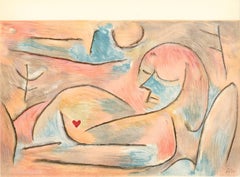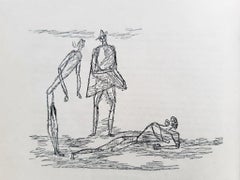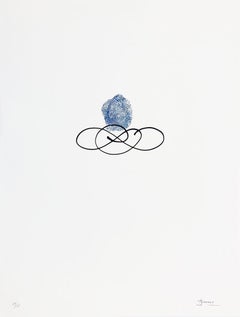Paul Klee More Art
Paul Klee was a Swiss-born German artist. His highly individual style was influenced by movements in art that included Expressionism, Cubism and Surrealism.
Klee was a natural draftsman who experimented with and eventually deeply explored color theory, writing about it extensively; his lectures Writings on Form and Design Theory (Schriften zur Form und Gestaltungslehre) — which were published in English as the Paul Klee Notebooks — are held to be as important for modern art as Leonardo da Vinci's A Treatise on Painting was for the Renaissance.
Klee and his colleague, Russian painter Wassily Kandinsky, both taught at the Bauhaus school of art, design and architecture in Germany. His works reflect his dry humor and his sometimes childlike perspective, his personal moods and beliefs, and his musicality.
Find original Paul Klee prints and other art on 1stDibs.
(Biography provided by Cerbera Gallery)
1930s Surrealist Paul Klee More Art
Lithograph
1920s Modern Paul Klee More Art
Paper
1980s Post-Minimalist Paul Klee More Art
Lithograph
Early 2000s Modern Paul Klee More Art
Paper
Late 19th Century Aesthetic Movement Paul Klee More Art
Lithograph
2010s Pop Art Paul Klee More Art
Lithograph, Screen
2010s Contemporary Paul Klee More Art
Lithograph
20th Century Modern Paul Klee More Art
Paint, Paper, Glue, Board, Magazine Paper
2010s American Modern Paul Klee More Art
Acrylic, Archival Paper
2010s Street Art Paul Klee More Art
Lithograph
2010s Contemporary Paul Klee More Art
Lithograph
Mid-20th Century Modern Paul Klee More Art
Glass, Wood, Paper
2010s Contemporary Paul Klee More Art
Lithograph
Early 2000s Modern Paul Klee More Art
Paper, Ink, Mixed Media, Lithograph, Offset
1930s Surrealist Paul Klee More Art
Lithograph
Paul Klee more art for sale on 1stDibs.
Artists Similar to Paul Klee
- What is Paul Klee famous for?1 Answer1stDibs ExpertApril 5, 2022Paul Klee is famous for his paintings that incorporate elements of the Cubist, Expressionist and Surrealist movements. Some of the Swiss-German artist's most well-known works include Senecio, Castle and Sun and Fish Magic. Shop a selection of Paul Klee art on 1stDibs.
- What was Paul Klee famous for?1 Answer1stDibs ExpertFebruary 27, 2024Paul Klee was famous for his artwork, which influenced a number of avant-garde styles. The Swiss-born German artist was a pioneer of Surrealist automatism, a way of drawing without focusing on conscious thought and instead letting lines occur automatically. He also made significant contributions to Primitivism, a style inspired by ancient techniques, and reductivism, which breaks familiar symbols down into their most basic parts. Some of Klee's most well-known works include Castle and Sun, Senecio, Cat and Bird, Fish Magic, Ad Parnassum, Angelus Novus and Flower Myth. Find a range of Paul Klee art on 1stDibs.
- 1stDibs ExpertApril 5, 2022Paul Klee had a style all his own and has been termed the father of abstract art, a Bauhaus master and a leader in Surrealism. Yet his paintings are still hard to define and are distinctly “Klee”. He embraced the abstract and relied heavily on shape and color as forms of expression, while leaving behind the material world. On 1stDibs, find a variety of original artwork from top artists.
- 1stDibs ExpertFebruary 21, 2024You can see Paul Klee paintings in many locations around the world. In the U.S., you'll find his works in the collections of the San Francisco Museum of Modern Art in San Francisco, California; the Museum of Modern Art in New York City, New York; the Phillips Collection in Washington, D.C.; the Museum of Fine Arts, Houston, in Houston, Texas; and the Art Institute of Chicago in Chicago, Illinois. Klee's paintings are also in many international museums, such as the Franz Marc Museum in Kochel, Germany; the Fondation Beyeler in Riehen, Switzerland; the Kunstmuseum Basel in Basel, Switzerland; and the Thyssen-Bornemisza National Museum in Madrid, Spain. Shop a selection of Paul Klee art on 1stDibs.
- 1stDibs ExpertApril 5, 2022Yes, artist Paul Klee was considered an abstract artist but did not start working in abstract until a visit to Tunisia in 1914. Prior to 1914 and following it, he continued to experiment with different artistic moments including surrealism, expressionism and cubism. But it is through his abstract work that he is best known and he produced the largest number of works of art. Shop a selection of Paul Klee pieces from some of the world’s top art dealers on 1stDibs.
- 1stDibs ExpertAugust 20, 2024How much a Paul Klee painting is worth depends on its condition, history and other factors. In 2011, his painting Tänzerin fetched more than $6.7 million at an auction in New York. Klee was inventive in his methods and techniques, experimenting with a huge array of different media. His works reflect an emotional lyricism, and he was unafraid to paint from a perspective of childlike innocence. His art frequently alludes to poetry, music and dreams and sometimes even includes words, symbols or musical notation. To find out the value of a particular work by the Swiss-German artist, enlist the help of an experienced art dealer or certified appraiser. On 1stDibs, explore a range of Paul Klee art.
- 1stDibs ExpertMarch 22, 2022Paul Klee was a prolific artist who created more than 9,000 works of art that include paintings, prints, drawings, mixed media pieces and sculptures. The Swiss-German artist’s compositions include elements of Surrealism, Expressionism and Cubism. You'll find a collection of Paul Klee art on 1stDibs.



